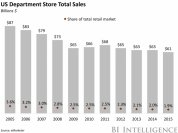This story was delivered to BI Intelligence “E-Commerce Briefing” subscribers. To learn more and subscribe, please click here.
Google Home, an internet-connected speaker that competes directly with Amazon’s Echo, now allows customers to order and pay for goods via voice command with Google Express retail partners, Retail Dive reports.
Those partners include a list of well-known brands such as Target, Whole Foods, Costco, Walgreens, PetSmart, and Bed Bath & Beyond.
Google Home owners will be able to use the voice shopping service to make purchases through Google Express without paying standard delivery and service fees until April 30. The internet giant says it plans to expand the voice shopping service in the future by adding more features and integrating with other retail apps and services.
Voice activated shopping is an area in which it will be key for Google to compete effectively with Amazon if it wants Home to become more popular. The Home was only launched two months ago and is far less mature than Amazon’s Echo product line and Alexa software, which has more than 3,000 integrations with other apps and services. However, despite the Echo’s two-year head start and growing popularity, only 32% of owners are using it to shop. That means that retail, Amazon’s bread-and-butter, could be a place where Google Home might quickly catch up to the Echo.
Google’s strategy could also draw more customers to the device. That’s because the firm is partnering with major retailers that consumers already shop from frequently, which could encourage use. In addition, Google is marketing the voice shopping feature as a way to handle everyday household purchases like groceries, pet food, or cleaning supplies — a strategy that could generate repeat purchases and help form habits. This will benefit Google by making the Home more essential to its owners, while enabling its retail partners to better promote their e-commerce businesses via entry into the smart home space.
Despite this, the U.S. smart home market has yet to truly take off. At its current state, we believe the smart home market is stuck in the ‘chasm’ of the technology adoption curve, in which it is struggling to surpass the early-adopter phase and move to the mass-market phase of adoption.
There are many barriers preventing mass-market smart home adoption: high device prices, limited consumer demand and long device replacement cycles. However, the largest barrier is the technological fragmentation of the smart home ecosystem, in which consumers need multiple networking devices, apps and more to build and run their smart home.
John Greenough, senior research analyst for BI Intelligence, Business Insider’s premium research service, has compiled a detailed report on the U.S. smart home market that analyzes current consumer demand for the smart home and barriers to widespread adoption. It also analyzes and determines areas of growth and ways to overcome barriers.
Here are some key takeaways from the report:
- Smart home devices are becoming more prevalent throughout the US. We define a smart home device as any stand-alone object found in the home that is connected to the internet, can be either monitored or controlled from a remote location, and has a noncomputing primary function. Multiple smart home devices within a single home form the basis of a smart home ecosystem.
- Currently, the US smart home market as a whole is in the “chasm” of the tech adoption curve. The chasm is the crucial stage between the early-adopter phase and the mass-market phase, in which manufacturers need to prove a need for their devices.
- High prices, coupled with limited consumer demand and long device replacement cycles, are three of the four top barriers preventing the smart home market from moving from the early-adopter stage to the mass-market stage. For example, mass-market consumers will likely wait until their device is broken to replace it. Then they will compare a nonconnected and connected product to see if the benefits make up for the price differential.
- The largest barrier is technological fragmentation within the connected home ecosystem. Currently, there are many networks, standards, and devices being used to connect the smart home, creating interoperability problems and making it confusing for the consumer to set up and control multiple devices. Until interoperability is solved, consumers will have difficulty choosing smart home devices and systems.
- “Closed ecosystems” are the short-term solution to technological fragmentation. Closed ecosystems are composed of devices that are compatible with each other and which can be controlled through a single point.
In full, the report:
- Analyzes the demand of US consumers, based off of survey results
- Forecasts out smart home device growth until 2020
- Determines the current leaders in the market
- Explains how the connected home ecosystem works
- Examines how Apple and Google will play a major role in the development of the smart home
- Some of the companies mentioned in this report include Apple, Google, Nest, August, ADT, Comcast, AT&T, Time Warner Cable, Lowe’s, and Honeywell.
To get your copy of this invaluable guide, choose one of these options:
- Subscribe to an ALL-ACCESS Membership with BI Intelligence and gain immediate access to this report AND over 100 other expertly researched deep-dive reports, subscriptions to all of our daily newsletters, and much more. >> START A MEMBERSHIP
- Purchase the report and download it immediately from our research store. >> BUY THE REPORT
The choice is yours. But however you decide to acquire this report, you’ve given yourself a powerful advantage in your understanding of the smart home market.


